Explainer
- Explainer
- Petrol prices
The battleground for Iran’s last stand could hold the world to ransom
Iran’s leader says he will not back down. Could he use a shipping choke point as leverage?
By Angus Holland and Jackson Graham
Visiting an oil refinery is nothing if not bewildering. It’s a cat’s cradle of dials and valves and spigots and pipes, fat and thin, some spewing steam; of towering columns and multi-storey cylinders, one topped with that iconic flickering plume of flame. Yet, despite its vast complexity, a refinery is a machine built to do one thing: in this case, to pump oil from tankers berthed at a jetty on its seaward side and pass it through its web of hissing conduits to be boiled, sifted, blended and tested until what emerges are batches of diesel, jet fuel and various grades of unleaded petrol.
This is the Viva Energy (formerly Shell) refinery, just outside Geelong on Victoria’s Corio Bay. It’s one of just two such facilities still operating in Australia and a survivor from the 1950s, albeit updated with mission-control flat-screens and increasingly sophisticated processes. This other-worldly place is a major contributor to how we consume petrol in Australia, yet it is still just a tiny piece of the global picture.
While Viva Energy refines some oil here, most of our fuel comes from overseas. And its famously volatile price is largely determined by forces out of our control – both economic and geopolitical – in Singapore, the Middle East and beyond. Embargoes, terrorism and wars can all affect the oil price – which has surged since Israel attacked energy facilities in Iran and destroyed much of the regime’s military command in recent days.
Now, with Supreme Leader Ali Khamenei promising “irreparable damage” to the US if it intervenes to support its ally Israel, there are fears he may look for leverage in another way: by blocking the Strait of Hormuz, a narrow choke point at the mouth of the Persian Gulf through which a third of the world’s oil is shipped. How would they do it? And what might it mean for petrol prices in Australia?
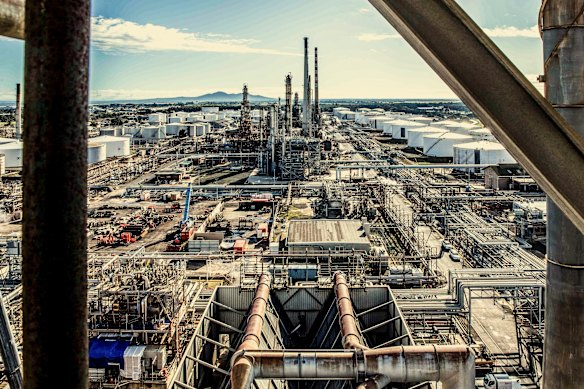
The refinery in Geelong is a maze of pipes and machines that transform oil into petrol.
First, where does petrol come from?
The sticky brown or black goop created over millions of years from compressed, decomposed algae and plankton on seabeds is something humans have known about for most of our history. In many places, oil used to just bubble out of the ground, as author Ed Conway notes in his book Material World, in which he analyses the necessity to civilisation of six key resources (oil being one). The ancient Egyptians originally took bitumen from tar pits to help embalm their dead; elsewhere it was used to waterproof the bottoms of boats. But it wasn’t until 1853, writes Conway, that chemists figured out how to process oil into a liquid that would burn strongly: kerosene. Cue a worldwide rush to discover sources of “black gold” to light our world.
Today, of course, petrol, diesel and other products refined from oil continue to dominate everyday life, despite the trend towards renewables. Scots and Norwegians pump oil from the depths of the North Sea; Texans from the ancient Permian Basin; the Russians in western Siberia; and the Saudis from the world’s largest single deposit, the vast Ghawar field, which produces some 3.8 million barrels of oil a day – enough to fill 242 Olympic-sized swimming pools. Worldwide, in 2025 we are on track to consume nearly 105 million barrels daily. That’s about 6600 pools’ worth. “How the world works right now,” Conway tells us from the UK, “is we’re still reliant on fossil fuels for about 80 per cent of all of our total primary energy”.
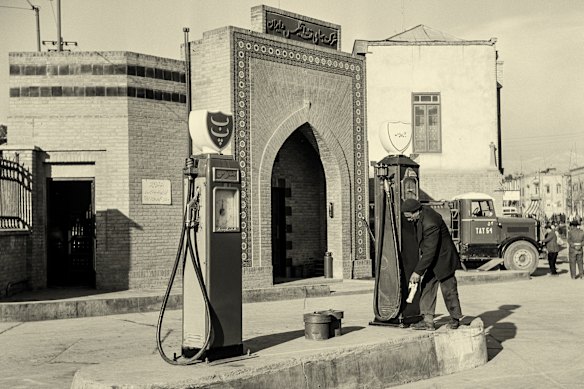
A man at a petrol pump, supplied with Iranian oil, in Tehran in 1948.Credit: Getty Images, digitally tinted
As it’s organic, oil is not a uniform product. It can be light or heavy, “sweet” or “sour”. Oil literally tastes more or less sweet depending on its sulphur content, a component of the algae and plankton that made it in the first place. Sulphur is a pollutant when burned in vehicles.
While one tanker-load of crude oil can vary greatly from the next, crude oil is still typically traded across just a handful of benchmarks, or reference points for prices. The best known, Brent crude, takes its name from Scotland’s offshore Brent Oilfield, named after the brant or brent goose (pictured below) when it was discovered in the East Shetland Basin in 1971. West Texas Intermediate, or Texas Sweet Light, is not a mid-strength ale but rather a benchmark for oil produced in the US, priced at the crude oil trading hub of Cushing, Oklahoma – the self-proclaimed “pipeline crossroads of the world”. The prices of Dubai crude and Oman crude are often averaged to create a benchmark for pricing crude oil shipped from the Middle East to Asia.

A brant goose. Credit: Getty Images
To turn it into usable petrol (and other products such as diesel and kerosene), refineries separate crude into its different components by pumping it through a vast network of furnaces, distilling tanks and pressure vessels. The crude is first heated and distilled, the lightest parts (such as the hydrocarbons that go on to form petrol) floating to the top and the heaviest (such as the components of heavy fuel oil) sinking to the bottom.
The next step is typically a method called “cracking”, using a rocket-shaped tower of a machine that employs heat, pressure and catalysts to turn less-valuable heavy hydrocarbon molecules into higher-value lighter ones. The final stage is to combine the different streams of petrol that emerge from these various processes, like a winemaker blending from different vats, to ensure the product that will come out of the pump has the correct characteristics, such as its octane level (in Australia that’s usually 95 or 98).

Saudi Crown Prince Fahd (who later became king) at an OPEC summit in Algiers in 1975 with Sheikh Ahmed Zaki Yamani, then Saudi minister of petroleum. Credit: Getty Image, digitally tinted
Who controls the world’s oil supply?
While there are dozens of oil-producing countries – the US, Norway, Britain and Malaysia among them – the cartel now known as OPEC+ holds the most sway over supply. Its members have about three-quarters of the world’s total known crude oil reserves and produce some 40 per cent of the world’s crude.
Originally a group of five oil-rich nations – Iran, Iraq, Kuwait, Saudi Arabia and Venezuela – the Organisation of the Petroleum Exporting Countries, or OPEC, collaborated to, essentially, seize control of production back from a cartel of seven British and US companies known as the Seven Sisters. By 1975, OPEC had expanded to 13 nations including Nigeria and Algeria. In 2016, it was joined by an alliance of more oil-producing nations, including the world’s third-biggest oil extractor, Russia, to create OPEC+.
Historically, OPEC has had little hesitation in manipulating supply. “By acting in a cartel manner, they’re able to exercise monopoly power [to] impact the price of oil on global markets,” says macroeconomist Robert Walker, a research fellow at international affairs think tank the Lowy Institute.
Within OPEC, the group’s single-biggest producer, Saudi Arabia, is the major player. Critically, says Ed Conway, “they still are able to actually get oil out of the ground and increase their output faster than pretty much any other country in the world — which can influence the global market”. Agility in production is one thing, getting the oil out to other markets beyond the Middle East is another.

Basij paramilitary force’s speedboats in the Persian Gulf in 2024 during commemorative celebrations for the expulsion of the Portuguese at the Strait of Hormuz in 1622.Credit: Getty Images, digitally tinted
How could the Iran-Israel conflict affect petrol prices?
So far, Israel’s attacks appear to have targeted Iran’s domestic oil and gas supply chains rather than its exports. Israeli airstrikes, for example, have hit Iran’s Shahr Rey refinery in Tehran’s south (which churns out 250,000 barrels of oil a day), the Abadan refinery near the Persian Gulf coast (400,000 barrels a day) and the Shahran oil depot, north of Tehran. About half of Iran’s oil production goes towards its domestic needs.
But one reason markets are on edge, says Shane Oliver, chief economist at AMP, is that Israel didn’t attack any Iranian oil facilities at all during strikes in April and October last year (an escalation after years of shadow aggression between the two nations), yet “this time they have actually attacked them”. The West Texas Intermediate and the Brent Index rose 7 per cent immediately after Israel launched its recent attacks.
What if Israel were to target Iran’s oil exports? In 2022, Iran’s mineral fuels, oils and distillation products accounted for more than half of its total exports. (Most of its trade is with countries such as China and Iraq, which operate outside US and European Union sanctions on Iran.) Iran’s oil exports make up just a fraction of global supply – about 4 per cent. “India and other countries are buying oil from Iran so if they can’t get their oil from Iran, then they go onto the world market and push up the price,” says Oliver. Yet the impact would be negligible, he says, as surpluses of oil in Saudi Arabia and the United Arab Emirates could make up for the shortfall.
Of greater concern is how Iran could disrupt the transit of oil. A third of the world’s traded crude oil is shipped through the Strait of Hormuz, a narrow passage near Iran that separates the Persian Gulf from the Arabian Sea and the wider world. In May, according to Lloyd’s List, nearly 518 million barrels of crude oil were transported through the strait, which is less than 40 kilometres wide at its narrowest and has a shipping lane about three kilometres wide in each direction.
If a chokepoint such as this becomes dangerous – as has the Bab al-Mandab Strait in recent times as Houthi militias attack commercial vessels, leading to a steep drop in the number of ships transiting there – or if it is effectively shut, trade has to reroute. Most of the ships that would have gone through the Bab al-Mandab Strait, in order to get into the Red Sea and through the Suez Canal, now ply their way around the southern tip of Africa instead.
The Saudis and UAE both have limited workarounds for the Strait of Hormuz: a Saudi pipeline to a Red Sea terminal means some shipments could get to Europe, the UAE has a pipeline from its oilfields to the Gulf of Oman. Iran has an export terminal at the eastern end of the strait, too, reports Bloomberg. Other nations, such as Kuwait, Qatar and Bahrain, rely entirely on the strait to ship their oil.
Iran, which is on the strait’s northern shores, could accomplish a blockade by laying mines or harassing commercial vessels with its naval boats, which include speedboats. A day after Israel’s initial attack, Iranian general Esmail Kosari said Tehran was reviewing whether to close the strait. This would cause “a major impact on oil supplies”, says Oliver, “simply because those countries with the spare capacity would be affected by the blockage, like Saudi Arabia and UAE.”
Oil is already trading at a five-month high because of the threat to supply; even the threat of closing the strait has had an effect; the cost of chartering a large tanker to move oil from the Middle East rose by as much as 20 per cent when the conflict broke out, according to Reuters.
It’s not the first time oil markets have faced such a threat. In the 1980s, during the Iran-Iraq War, the two sides attacked 451 vessels between them, in what became known as the Tanker War. The strait was not closed then, though, partly because of US threats to intervene if it was – the US Navy escorted tankers through the Gulf. This time around, Iran would be reluctant again to provoke the US to directly join the conflict. So far, shipping is in a “wait and watch” mode, reports Lloyd’s List, although tankers waiting to load up in Iran are staying at greater distance from ports, something Iran has requested.
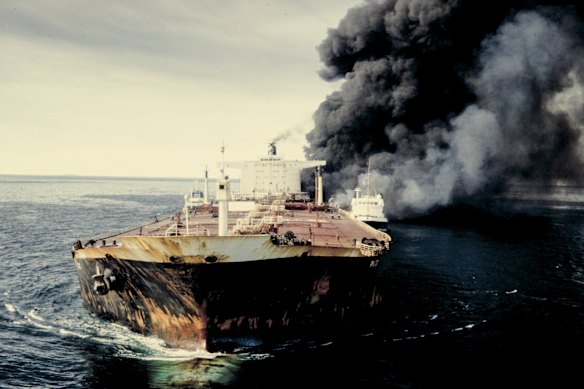
A tanker in flames in the Strait of Hormuz in 1987 during the Iran-Iraq War.Credit: Getty Images, digitally tinted
Indeed, some analysts this past week have said there’s no cause for alarm, at least with respect to oil prices. JP Morgan’s commodities team has put a 17 per cent possibility on a worst-case scenario “where supply impact extends beyond the reduction in Iranian oil exports and price reaction is exponential”. “Historically, Iran has refrained from closing the passageway, likely indicating a preference to avoid escalating numerous conflicts from hybrid warfare into full-blown war,” they noted in a briefing shared with us.
Still, Iran could use the possibility of blocking the strait as a “blackmail tool”, warns Joaquin Vespignani, an associate professor of macroeconomics at the University of Tasmania. “If they just keep moving, for example, military forces to this area, that will cause Israel to attack this area or close to it,” says Vespignani, who has studied previous oil price shocks. “That is the big concern – it doesn’t really have to be blocked to feel the effect. If the war moves to this area, even if the channel is not blocked, there will be some consequences.”
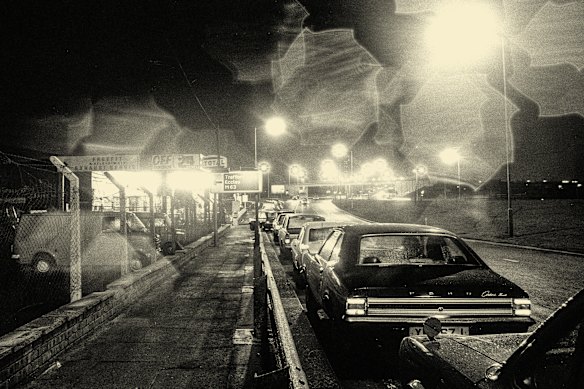
In Manchester, UK, in 1974, cars queue for petrol ahead of a price rise at midnight due to the ongoing OPEC embargo.Credit: Getty Images, digitally tinted
What could be the impact for Australia?
For as long as we’ve known its importance, oil has not only fuelled wars but sparked them, as Daniel Yergin writes in his encyclopaedic analysis The Prize. Oil played a fundamental role in both world wars, he writes, not to mention the later Suez Crisis of 1956 when Britain and France saw shipments of oil as one of the key strategic reasons for the canal remaining open.
The first “oil crisis” that saw petrol prices significantly spike worldwide was in 1973 when Arab oil-producing nations embargoed the US and other countries who had supported Israel in the Yom Kippur War, causing prices to soar by 400 per cent - cue queues at the bowser and a rush towards more fuel-efficient vehicles. Another crisis came after the 1979 Iranian revolution, when fear ripped through markets that the social upheaval could spread to the region’s other oil-rich nations. In 1990, Iraq’s invasion of Kuwait – a fellow OPEC member – triggered the first Gulf War and brought on a “mini oil shock” that lasted nine months and contributed to a recession in the US.
“In Australia, given that 90 per cent of our oil consumption – petrol and diesel and all sorts of things – come from overseas we are vulnerable to any international crisis that may affect us, directly or indirectly,” says associate professor Flavio Macau, a logistics expert at Perth’s Edith Cowan University. “At the end of the day, we’re an island. Everything must come by sea.” While we do have our own limited oil reserves, mostly in Western Australia, and the two refineries – Viva Energy’s and Ampol’s Lytton plant in Brisbane – ultimately we have to compete with imports on price.
But Australian prices today are also heavily influenced by three other factors: the strength of the US dollar, the margins that overseas refineries make and the wholesale benchmark in Singapore. The dollar matters because oil trades are made in US dollars. Australia’s dollar is currently about 65 cents to the US dollar. Refiners are turning a “crude” substance into any number of other products including petrol and diesel.
Singapore matters as our dominant regional supplier, home to three major refineries, including one of the largest plants owned by multinational giant ExxonMobil – one of many petrochemical companies that now sprawl over the city-state’s Jurong Island. Because of the volume coming out of Singapore, Australian wholesale prices for petrol are not so much pegged to the price of crude as they are to a Singapore benchmark known as Singapore Mogas 95 Unleaded, or Mogas 95 for short.
Says Shane Oliver: “If you look at the correlation between global oil prices and Australian petrol prices, the $12-a-barrel rise in oil prices so far this month, including the rise since the attacks, could translate to about 12 cents a litre in petrol prices. That’s a very rough rule of thumb but, obviously, it will gradually filter through as oil goes through the refinery process, including in Singapore, and then eventually shows up to the bowser in Australia.”
It takes weeks for any disruption of oil supply to impact Australian motorists, says Joaquin Vespignani at UTas. Hidden costs can include insurance premiums on cargo travelling through dangerous waters; and fuel for transporting food to stores, says Vespignani. There’s yet another factor that influences what we pay at the pump: the all-important and often mysterious “retail price cycle”.
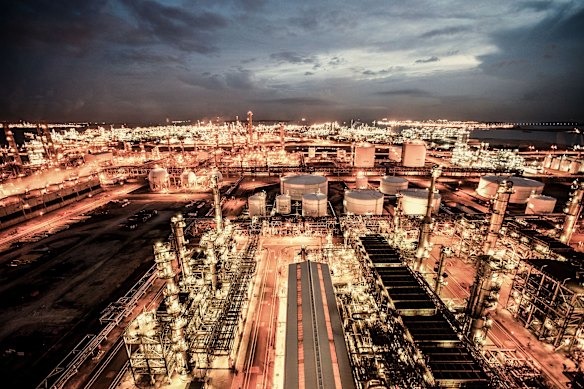
An oil refinery on Jurong Island in Singapore.Credit: Getty Images, digitally tinted
What’s the retail price cycle?
Glance at fuel prices leading into a long weekend and it can be tempting to think service stations hike up the prices when more motorists get on the road. Nevertheless, this is not actually the case, says the Australian Competition and Consumer Commission, which has found that any price increases on public holidays are no larger than at other times of the year.
Instead, it is fierce competition among service stations that drives prices to fall then rise over an average of five weeks in most Australian capital cities, before the cycle starts again – a game of discount leapfrog. Economists call it an Edgeworth cycle (named for the economist who described it, in the 1920s). “I started high, I wanted to take volume off you so I dropped by a cent, and you saw what I was doing so you dropped by a cent,” explains Mark McKenzie, chief executive of the Australasian Convenience and Petroleum Markets Association.

A man waits in line at a petrol station west of Tehran on June 17 as Iranians stockpile amid attacks from Israel.Credit: Getty Images, digitally tinted
The prices eventually fall low enough to be unsustainable, at least for some. “It’s a bit like looking at each other around the poker table and trying to work out who is going to move first,” says McKenzie. Generally, it’s the larger-volume businesses potentially exposed to bigger losses that will blink and up prices. Average prices can move by up to 45 cents from trough to peak.
“It’s not perfectly competitive but it’s not bad,” says behavioural economist Professor Ralph-Christopher Bayer of Adelaide University. “It’s not that they’re really able to have huge margins.”
In Western Australia, regulation requires fuel prices to be locked in for 24 hours from 6am each day, which has contributed to a seven-day fuel cycle in Perth, where prices are typically lowest on a Tuesday.
McKenzie says a common misconception is that service stations collude over when to put up prices. The 8130 service stations in Australia are managed by around 3500 different businesses. “Individual businesses are making decisions about when they go up,” he says. The margin on regular unleaded fuel is wafer thin. More than half of pump prices come from production costs, another 31 per cent is government tax, and 11 per cent is industry operating costs and margins, according to the Australian Institute of Petroleum. McKenzie says service stations on average make about 2.8 cents a litre on regular unleaded fuel. “They get a better margin on the premium graded product,” he says, which can increase margins up to four cents per litre.
Fuel remains a service station’s main profit source because of the sheer volume sold, but it’s no industry secret they make bigger margins on non-fuel items – chocolate bars, drinks. “If I lose you because I’ve made a silly decision on pricing,” says McKenzie, “it’s a double banger because I don’t just lose the fuel, I lose the opportunity to sell the non-fuel products.”
Oil’s heyday is not over yet. Indeed, the notion of “peak oil” supply, which once implied a plunge into Middle Ages darkness, has become more complicated with the discovery of new deposits and technologies and the need to ensure continued supplies as new types of energy come online. Says Ed Conway: “We’re trying to compress a kind of period of innovation that when you look back at previous energy transitions would have taken probably a century, if not longer.”
This is an updated version of an Explainer first published in September 2023.
Get fascinating insights and explanations on the world’s most perplexing topics. Sign up for our weekly Explainer newsletter.
Let us explain
If you'd like some expert background on an issue or a news event, drop us a line at explainers@smh.com.au or explainers@theage.com.au. Read more explainers here.